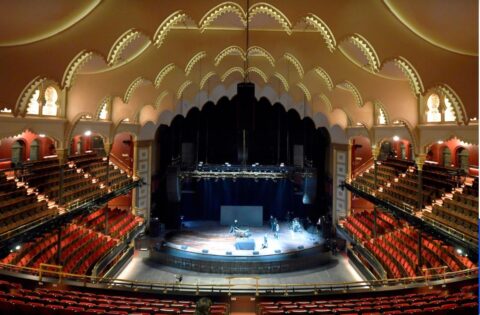Music Read

Massey Hall – if you’ve played there, you’ve arrived. If you’ve attended a concert there, you’ve felt it reverberate with the echoes of history. What you may be unaware of as a listener, however, is the way Massey’s magical acoustics reverberate – and not in a sublime way – for the mixing professionals who must find ways around the venerated hall’s many quirks.
Hallowed ground for musicians of all stripes, and built within three years of Carnegie Hall, the Massey auditorium brings audience and performers together in warm, living room-like intimacy. It’s a remarkable feat, given its size. Built well before the advent of electronic amplification, and long before amplified performance became widespread in the 1950s, Massey Hall was designed with one thing in mind: to transmit sound beautifully. Every surface of the room, from the floor to the walls to the ceiling, has an impact.
Indeed a quiet murmur from the stage can be heard, without amplification, from the last of the uppermost rows. “But it can be a difficult room for louder acts to play,” explains Doug McKendrick, Director of Production at Massey Hall. The hall’s acoustic restoration requires taking care to treat all surfaces that reflect sound, particularly that emanating from the speakers. “We do have difficulties with musicians hearing themselves well, and that’s due to the shape of the dome above the stage.”
Further complicating things is the ‘flutter echo’ which bounces from side to side, generating 13 discrete repeats. But the main culprit that muddies sound and disorients artists is ‘slapback.’ The rear and stage walls face each other at a 90 degree angle, and when a high-pressure stream of sound exits the speakers, it literally slaps back toward the stage, almost at full amplitude, and collides with the out-going stream of sound from the PA system.
The solution to this involves some considered, but complicated tweaks. “It’s a careful balance between making it better for electrified music, and not changing a thing,” says McKendrick. “You want to be selective.”
This is why Massey Hall has brought in Bob Essert, a renowned acoustician whose magic touch has been applied to many beloved venues, locally and internationally. “Taking the amplified sound to a new level of excellence is the primary driver” of the fine-tuning work Essert is overseeing at Massey. Some of the very attributes which make the hall such an architectural gem also present the greatest challenges.
“Clearly the hall works beautifully well already, but enhancing amplified sound for the majority of productions is the way forward. The gold-domed stage ceiling is an essential architectural element, and there’s little room to change much. The plan is to design and install a more open array of acoustic surfaces over the stage ceiling,” which will scatter and absorb the echoes.
The hall’s elaborate centre ceiling is also surfaced with hard plaster, and first showed signs of wear in 1955. Though not entirely visible to the eye during a concert, it is covered entirely with wire mesh, installed in 1968 after bits of plaster began to deteriorate and fall. The architects and conservationists have been consulting with specialists who can reinforce the plaster and lathe from the attic side, strengthening it and securing its bond to the wooden lathe. The mesh will come down and, amazingly, the original plaster will remain intact: the same ceiling, but lasting well into the future.
The stage-facing sides of the scallops and rafters that span the ceiling will also receive surface treatments, along with the wall and ceiling surfaces in the top galleries. And finally, new upholstered seating will replace the current 1948 movie theatre style reclining seating, as well as the wooden gallery seating whose acoustic reflectivity has caused such headaches. In addition to being vastly more comfortable, upholstered seats throughout will assist the audio engineers in better spanning the gulf between mixing to an empty hall at soundcheck and the transformation of sound quality when the house fills with people.
The coming acoustic tweaks and innovations will bring amplified sound in Massey Hall to new levels of excellence, while retaining what the hall is most known for: its warmth. The restoration also opens up new possibilities for a wider array of musical styles and genres, enabling a broader palette of music to sound as gorgeous as Massey’s reputation lays claim to.
While this only skims the surface of a many-layered restoration and acoustic revitalization, it is clear that the skilled teams involved prioritize retaining and enhancing the Massey auditorium’s signature warmth and historic character, safeguarding its legacy for future generations of music lovers. “The project really is unique,” says McKendrick, “in that it is part painstaking restoration and part new construction.” He gestures across the expanse of the hall, from the stage to the exit doors. “And they both meet here at the back wall.”
